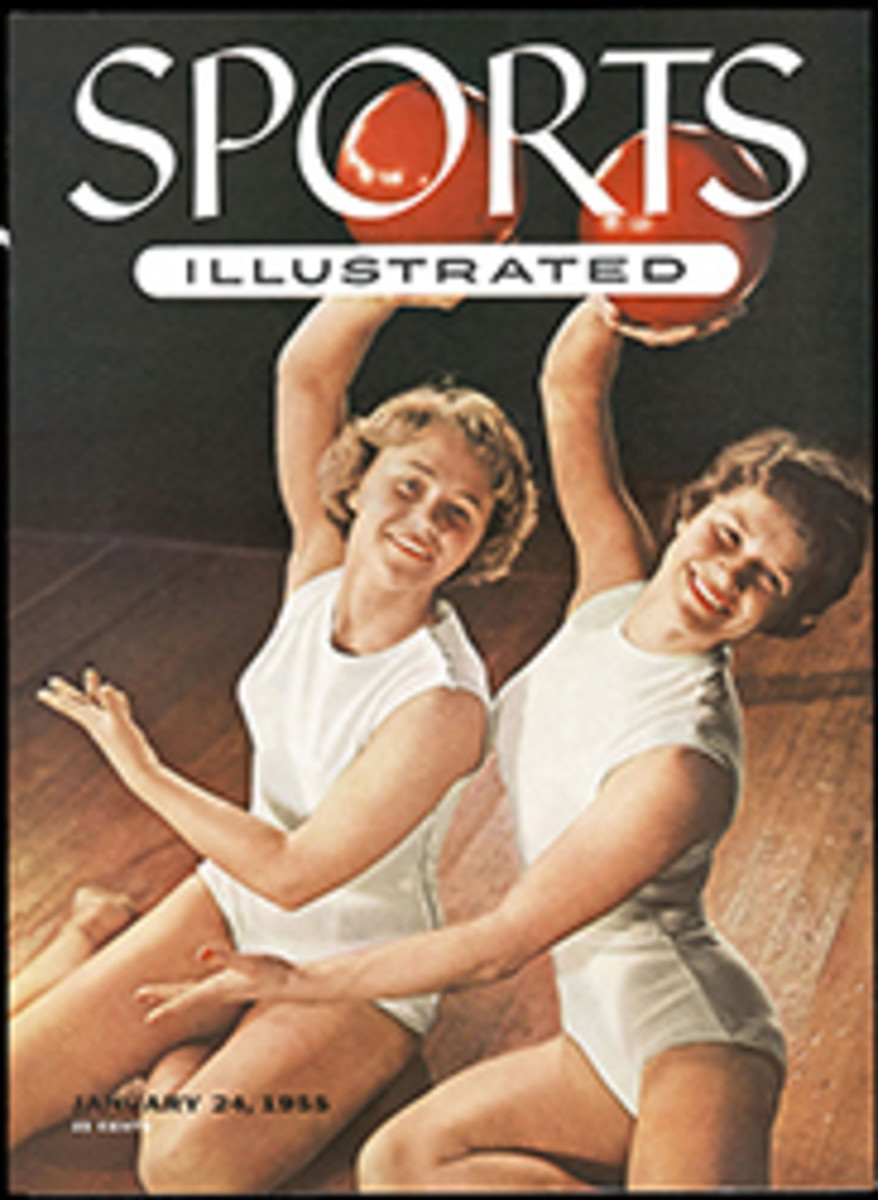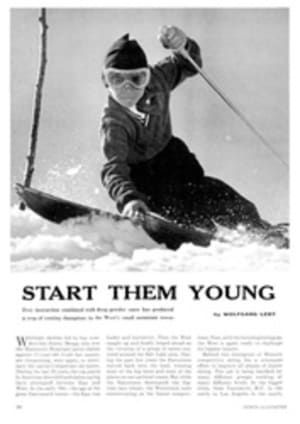
A FIRST LOOK: WORLD'S MOST EXCLUSIVE GOLF COURSE
The most recently built, and perhaps the most interesting, of President Eisenhower's golfing loci is a new four-hole pitch-and-putt course which a number of his friends have provided for him at Camp David, the presidential weekend retreat in the Catoctin Mountains of Maryland. Here, a rustic-type lodge perches atop a ridge. There is a terrace in front, and then the land slopes quickly down to a small clearing that was devised by President Roosevelt (F.D.) so that a person lolling on the terrace could command a superb view of the countryside—on a clear day, a 30-to 40-mile vista. From the terrace to the edge of the wood line, the cleared lawn measures about 140 yards and runs to about the same yardage in width. This is hardly enough room for even one good golf hole, but Robert Trent Jones, the golf architect who was called in, dealt with the spatial problem with fine imagination. At the left of the clearing Jones built an Augusta-type green, and then created four tees along the right-hand edge—the first, 100 yards distant and 15 feet above the level of the green; the second, 140 yards distant, 20 feet above; the third, 120 yards distant, 20 feet below; and the fourth, 80 yards distant and 15 feet below. Carrying his mashie and pitching irons, a player hits his shot from each of the four tees, in counter-clockwise order, then moves up to the green to hole out his four balls. It offers a splendid variety of shots and no confusion in a foursome as long as each player uses a clearly distinguishable set of balls—like ones imprinted with MR. PRESIDENT.
THE GAME AND THE PRESIDENT
In Round in Sixty-Eight, one of his entertaining books mainly but not entirely about golf, Henry Longhurst (of the London Sunday Times) records a visit he had not long ago with Gene Sarazen. In recent years Gene has divided his energy equally among golf, selling precision gears, and farming, and after remarking that this diversification probably accounts for Sarazen's wonderful vitality, Longhurst proceeds to an adhesive quotation by Winston Churchill. The quotation comes from Churchill's Painting As a Pastime and it goes like this: "Change is the master key. A man can wear out a particular part of his mind by continually using it and tiring it, just in the same way as he can wear out the elbows of his coat. There is, however, this difference...one cannot mend the frayed elbows of a coat by rubbing the sleeves or shoulders, but the tired parts of the mind can be rested and strengthened merely by using the other parts."
This restorative value is, of course, one of the attractions which President Eisenhower finds in painting, and in his golf as well, another recreation potent enough to command a man's full concentration and send him back rested and refreshed to tackle the pressureful problems from which it gave him respite. To pursue painting presents no true complications for a prime minister or a president, but golf requires a larger canvas and is, in fact, just about the most difficult diversion for a chief of state to practice in privacy. However, there are solutions and the President has arrived at his. When he is in Washington, he plays at Burning Tree, a sequestered course about a half hour's drive from the White House, where the members—for the most part officials in our own and foreign governments—were instructed early in the game to respect the President's need of privacy, and they have. So have the members of the Cherry Hills course in Denver, the scene of the 1938 Open, where the President plays on his summer holiday; and likewise the members of his third course, the famed Augusta National, where he takes his spot vacations in the "Little White House," a white frame cottage next to Bob Jones's and only about 60 yards from the tee on the redoubtable 10th. At Augusta, the President usually plays the second nine first.
A president's duties, however, will not always let him get away for a round of golf, and during the past year a number of his friends, realizing the great therapeutic that hitting a few shots is for him, have acted to equip him with some backyard facilities. The next time you are in Washington, if you walk along the western border of the South Lawn of the White House and peer through the iron fence, you will notice a small putting green. (You really can't miss it, for though the flag is an inconspicuous dark gray, the pin is striped red and white.) The green was the gift of the U.S. Golf Association and was built by Alexander Radko, the director of the northeastern office of the USGA's Green Section. It is some 3,000 square feet in area, about half the size of an ordinary green, and the grass is a polycross creeping bent, a strain developed by Prof. H. S. Musser of Penn State where Milton Eisenhower is president. The turf was transplanted from the nursery of the Aronomink Golf Club, near Philadelphia, and the whole job of construction ran to $1,300, including the shallow trap that the President asked Mr. Radko to cut behind the green so that he could work on his recoveries. As for his new practice course at Camp David (above), it is, to be sure, a practically perfect solution for a golfing president.
Golf has been good for the President, and the converse is no less true: he has been extremely good for golf. Since 1913, or ever since Francis Ouimet's surprising triumph in the Open championship started to take the curse off the game as the affected importation of the upper crust, golf has steadily become a more and more democratic and popular pastime. Today it is as all-strata in its following as fishing, and if anything, the driving range may have even replaced the pool room. At the same time, until President Eisenhower took office, wearing his scorecard on his sleeve, golfers remained somewhat suspect in the eyes of many of their countrymen who persisted in viewing the breed as die-hard Tories who, if you didn't keep a watchful eye on them, would ask for a finger bowl at a hamburg stand, and in French. "Before Ike came in," a New York enthusiast recently confessed, "every time I carried my golf bag down to Grand Central and boarded a train for a golfing weekend, I could count on running into disapproving faces and at least one slur carefully delivered so that I could overhear it—you know, something like, 'Don't strain yourself, Reginald.' Now it's all changed. Strangers look at me as if I were a member of the 4-H Club. And when they speak to me, they give me the warm smile and a cheery word like, 'Looks like a grand weekend to get out of doors.' All of a sudden, I'm on the same level with the Fourth of July and Mom's Apple Pie, and I like it."
[originallink:10458806:42765]
ILLUSTRATION
ANTHONY RAVIELLI
HOLE | LENGTH | PAR |
1 | 100 | 3 |
2 | 140 | 3 |
3 | 120 | 3 |
4 | 80 | 3 |

